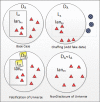Privacy preserving interactive record linkage (PPIRL)
- PMID: 24201028
- PMCID: PMC3932473
- DOI: 10.1136/amiajnl-2013-002165
Privacy preserving interactive record linkage (PPIRL)
Abstract
Objective: Record linkage to integrate uncoordinated databases is critical in biomedical research using Big Data. Balancing privacy protection against the need for high quality record linkage requires a human-machine hybrid system to safely manage uncertainty in the ever changing streams of chaotic Big Data.
Methods: In the computer science literature, private record linkage is the most published area. It investigates how to apply a known linkage function safely when linking two tables. However, in practice, the linkage function is rarely known. Thus, there are many data linkage centers whose main role is to be the trusted third party to determine the linkage function manually and link data for research via a master population list for a designated region. Recently, a more flexible computerized third-party linkage platform, Secure Decoupled Linkage (SDLink), has been proposed based on: (1) decoupling data via encryption, (2) obfuscation via chaffing (adding fake data) and universe manipulation; and (3) minimum information disclosure via recoding.
Results: We synthesize this literature to formalize a new framework for privacy preserving interactive record linkage (PPIRL) with tractable privacy and utility properties and then analyze the literature using this framework.
Conclusions: Human-based third-party linkage centers for privacy preserving record linkage are the accepted norm internationally. We find that a computer-based third-party platform that can precisely control the information disclosed at the micro level and allow frequent human interaction during the linkage process, is an effective human-machine hybrid system that significantly improves on the linkage center model both in terms of privacy and utility.
Keywords: Electronic Health Records (EHR); decoupled data; entity resolution; medical record linkage; privacy; privacy preserving interactive record linkage (PPIRL).
Figures




References
-
- Bronstein J, Lomatsch C, Fletcher D, et al. Issues and biases in matching medicaid pregnancy episodes to vital records data: the Arkansas experience. Mater Child Health J 2009;13:250–9 - PubMed
Publication types
MeSH terms
LinkOut - more resources
Full Text Sources
Other Literature Sources

